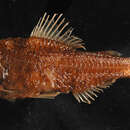Comprehensive Description
(
Anglèis
)
fornì da Smithsonian Contributions to Zoology
Diaphus metopoclampus
This questionably bipolar, temperate-semisubtropical species (Backus et al., 1977) is found in the Atlantic Ocean mainly south of 30°S (Krefft, 1974) and north of 20°N (Nafpaktitis, 1968). Although everywhere rare, it seems to be most abundant in the slope water areas (Nafpaktitis et al., 1977). This is a fairly large myctophid, reaching a size of about 80 mm; maximum size in the Ocean Acre collections is 79 mm. The species is “uncommon” in the study area; a total of 125 specimens was caught, 70 were taken during the paired seasonal cruises. Discrete-depth samples account for 51 fish, of which 47 are from noncrepuscular tows (Table 23).
DEVELOPMENTAL STAGES.—Postlarvae were 6–8 mm, juveniles 9–35 mm, subadult females 71–79 mm, and adult males 62–75 mm SL. No subadult males or adult females were taken. With the possible exception of size, there is no sexual dimorphism (Nafpaktitis, 1968). Although no adult females were caught, a 74 mm female taken in August had a few large ova (0.2–0.3 mm) and slightly enlarged ovaries. Gravid females 55–60 mm have been taken in the Gulf of Mexico (Nafpaktitis et al., 1977). Grey (1955) reported that a 73 mm female taken near Bermuda in August 1948 contained eggs in cleavage. This report has not been confirmed.
REPRODUCTIVE CYCLE AND SEASONAL ABUNDANCE.—The life cycle of D. metopoclampus in the Bermuda area apparently is complex and, like that of its congener D. rafinesquii, may involve migrations into and possibly out of the area. It cannot be determined whether D. metopoclampus spawns in the area. Although the life span cannot be determined from the present data, it probably is at least two years. The parent population spawns over a relatively short time, probably in spring or summer.
All specimens caught were either 6–35 mm or 62–79 mm. The want of intermediate sizes in the Ocean Acre collections almost surely reflects their absence in the study area rather than a sampling bias. If intermediates were present, at least one specimen would have been caught during the 14 cruises. The missing sizes have been taken in midwater trawls fished in the slope water (Krueger et al., 1975; Jahn, 1976; personal observation) and in the Gulf of Mexico (Nafpaktitis et al., 1977). This means that large fish must migrate into the Bermuda area with some regularity to maintain their numbers. Small fish either migrate out of the area or die before they reach about 40 mm.
Small fish were mostly 9–12 mm in September to October, 13–17 mm in January to March, 20–26 mm in June, and 25–30 mm in July. Presumably those taken in June and July were 10–12 months old. It follows that large fish taken at those times were a year or more older than the small fish, and that the life span is at least two years.
The catch in September (one cruise only; none were taken during other September cruises) was almost exclusively 9–12 mm juveniles. The smallest of these fish probably were recently transformed juveniles, which suggests that spawning either takes place in the study area or in close proximity to it. The relatively large number of small fish taken in September (although not in discrete-depth samples) may indicate a peak in spawning activity at or just before that time.
Abundance was greatest in winter (Table 47). In late spring it was only about one-third as great as in winter. No estimate of abundance could be made for late summer because no specimens were caught in noncrepuscular discrete-depth samples. If spawning occurred in spring or summer, abundance would be greater in late summer than in winter.
VERTICAL DISTRIBUTION.—Depth range by day in winter is 501–850 m with no apparent concentration at any depth, and in late spring 601–750 m with a maximum abundance at 601–700 m. By night, depth range is 401–800 m in winter with a maximum at 651–750 m, and in late spring 351–400 m (1 specimen) and 551–600 m (3 specimens) (Table 47). Three postlarvae were caught at 45 m near dawn in late summer. Gibbs et al. (1971) noted that an 18 mm fish was taken at 201–250 m by night in April.
These data show that small juveniles (13–19 mm) do not migrate regularly, and that at least some large fish over 60 mm remain at day depths during the night (Table 47).
- sitassion bibliogràfica
- Gibbs, Robert H., Jr. and Krueger, William H. 1987. "Biology of midwater fishes of the Bermuda Ocean Acre." Smithsonian Contributions to Zoology. 1-187. https://doi.org/10.5479/si.00810282.452

